How to Develop a Training Plan for Kittens
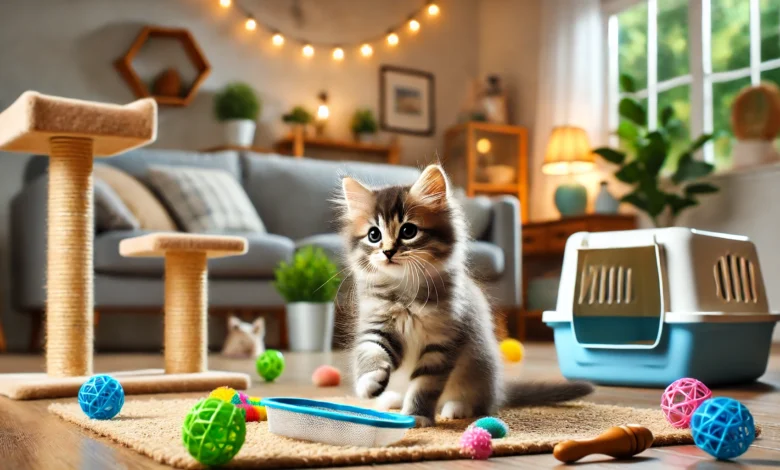
One of the most essential things you can ever do to guarantee happiness and health for you and your feline friend is to develop a training plan for your kitten.
Because kittens are naturally curious, playful, and willing to learn, the early stages in the kitten’s life provide the perfect time to introduce a structured training plan.
A well-trained kitten will not just avoid destructive behavior, but it will also be more manageable when it grows into an adult.
Whether it’s training your kitten to use a litter box, socialization, or teaching basic commands, you need a solid training plan to ensure success.
So, how do you build a good training plan for your kitten?
This article will take you through everything you need to know about designing a customized kitten training plan, breaking down each step to follow.
Table of Contents
Why Kittens Should Be Trained
Training your kitten entails much more than just teaching tricks.
It lays the foundation for good behavior and strengthens the relationship between you and your pet.
Early training helps your kitten understand boundaries and makes the home environment more harmonious.
Kittens that receive early training are less likely to develop behavioral issues later in life, such as aggression, fearfulness, or compulsive scratching.
Additionally, training helps you understand your kitten’s personality and behavior, allowing you to adjust your approach as needed.

The Benefits of Early Training
Early training sets kittens up for success in life.
Kittens are more receptive to training at a younger age, and they learn from their environment quickly and naturally.
By starting early, you can shape their behaviors before bad habits form.
Some major advantages of early training include:
- Better socialization: Early training helps kittens become comfortable around people, other pets, and new environments.
- Fewer behavioral problems: Training curbs unwanted behaviors such as furniture scratching, biting, and excessive meowing.
- Improved communication: Training enhances your ability to communicate with your kitten, helping you manage their needs and behaviors as they grow.
- A stronger bond: Time spent training your kitten helps to strengthen the emotional connection between you and your pet.

How Training Helps Build a Strong Bond
One of the most rewarding aspects of training is the bond it creates between you and your kitten.
Through training, your kitten learns to trust and rely on you.
Training provides quality one-on-one time with your pet, and they begin to look to you for guidance, love, and leadership.
A well-trained kitten listens better, which further strengthens the bond you share.
Do you think your kitten is already closely bonded with you, or could you use more quality time together?
Training is a fun and interactive way to build that bond!
Early training for kittens is crucial for shaping their behavior and building a strong bond with them. It prevents future issues like aggression and destructive habits.
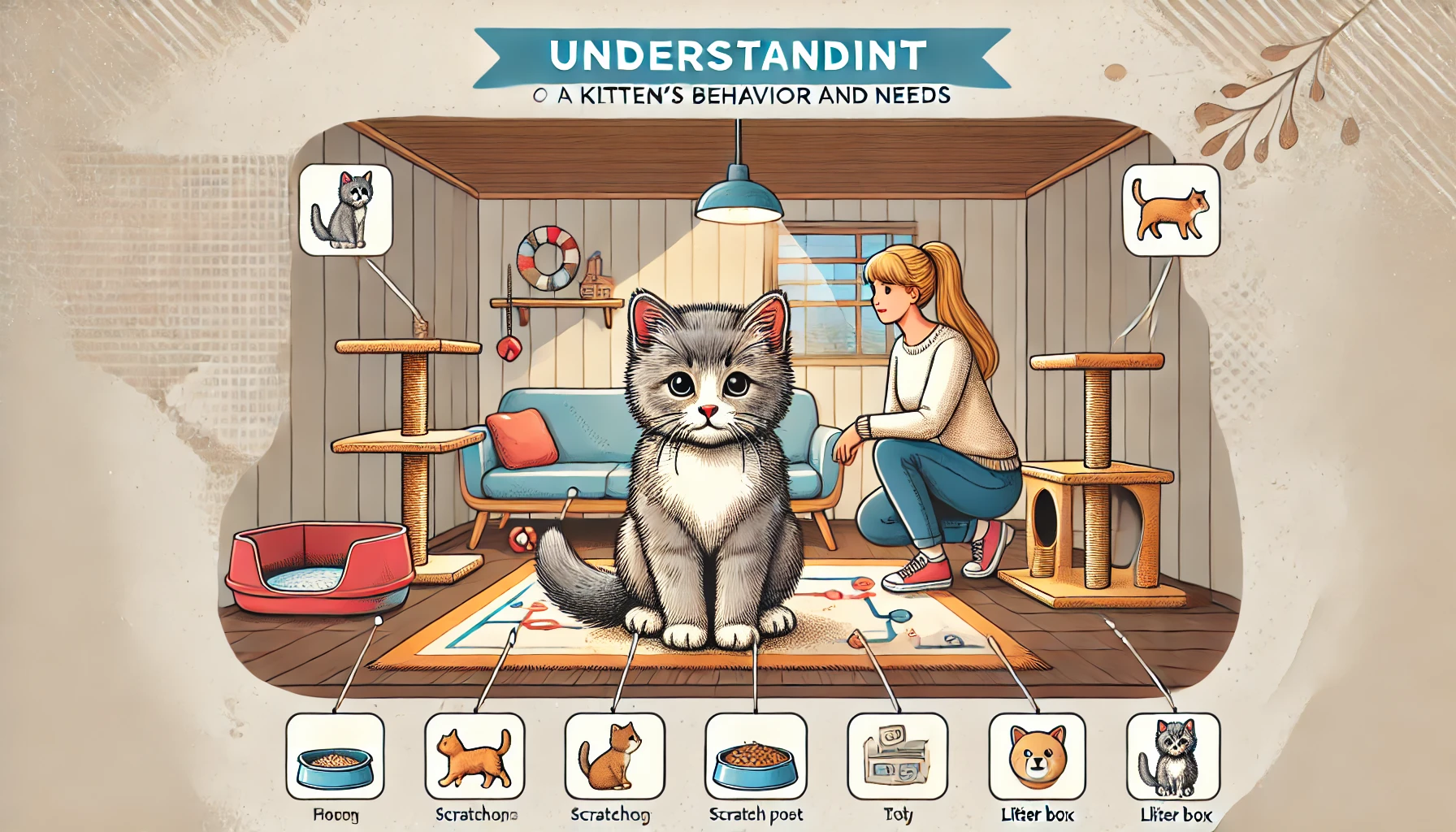
Understanding Your Kitten’s Behavior and Needs
Before you can effectively create a training plan for your kitten, it is necessary that you understand their behavior and particular needs.
Kittens, like all other young animals, go through developmental stages that will affect how they learn and approach the world around them.
By knowing how kittens perceive the world, you can better mold a training plan in accordance with specific behavioral traits and natural instincts.
Without understanding these key elements, training can become frustrating for both you and your kitten.

How Kittens Learn: The Basics
Kittens are fast learners, and they do most of their learning within the first few weeks.
They tend to be naturally inquisitive and learn by investigating the things happening around them.
They also rely heavily on repetition and reinforcement to learn effectively.
Reward-based training, such as offering treats or affection, works better on kittens than punishment, which can cause fear or anxiety.
Here are some general points on how a kitten learns:
- Observation: Kittens learn by watching and observing. If you have older cats at home, your kitten may mimic their behavior—good or bad.
- Exploration: Kittens have the instinctive urge to explore. This is how they learn about their environment, including where to find food, water, and the litter box.
- Play: Play helps kittens develop physical coordination and social skills. It’s also an excellent way to establish commands and boundaries with your kitten.
- Consistency: Through repetition and consistency, desired behaviors can be reinforced. Without consistent cues and rewards for good behavior, your kitten may become confused about what is expected of them.

Recognizing Signs of Stress or Fear
Training your kitten requires patience, but it is equally important to recognize when your kitten is stressed or frightened.
Forcing your kitten beyond their comfort zone during training can be counterproductive and lead to setbacks.
Stress can manifest in behaviors such as hiding, excessive meowing, or avoiding interaction.
Being sensitive to these signs can help you modify your approach and ensure the training experience remains positive.
Common signs of stress in kittens include:
- Hiding or retreating to quiet spaces
- Increased vocalization, such as meowing or hissing
- Aggressive behavior, like biting or scratching
- Loss of appetite or refusal to eat
If you notice any of these signs, it’s best to slow down the training, give your kitten a break, or create a less stressful environment.
A well-adjusted kitten will be more receptive to learning.

Troublesome Kitten Behaviors to Consider
Not all kitten behaviors are problematic, but some require attention early on to prevent issues as they grow.
Here are some common behaviors you may want to address:
- Scratching: While scratching is a natural instinct, training your kitten to use scratching posts can save your furniture.
- Play biting: Although biting is natural during kitten play, it’s important to teach them not to bite humans or other pets.
- Nighttime activity: Kittens are often more active at night. Engaging them with play during the day can help regulate their sleep schedule.
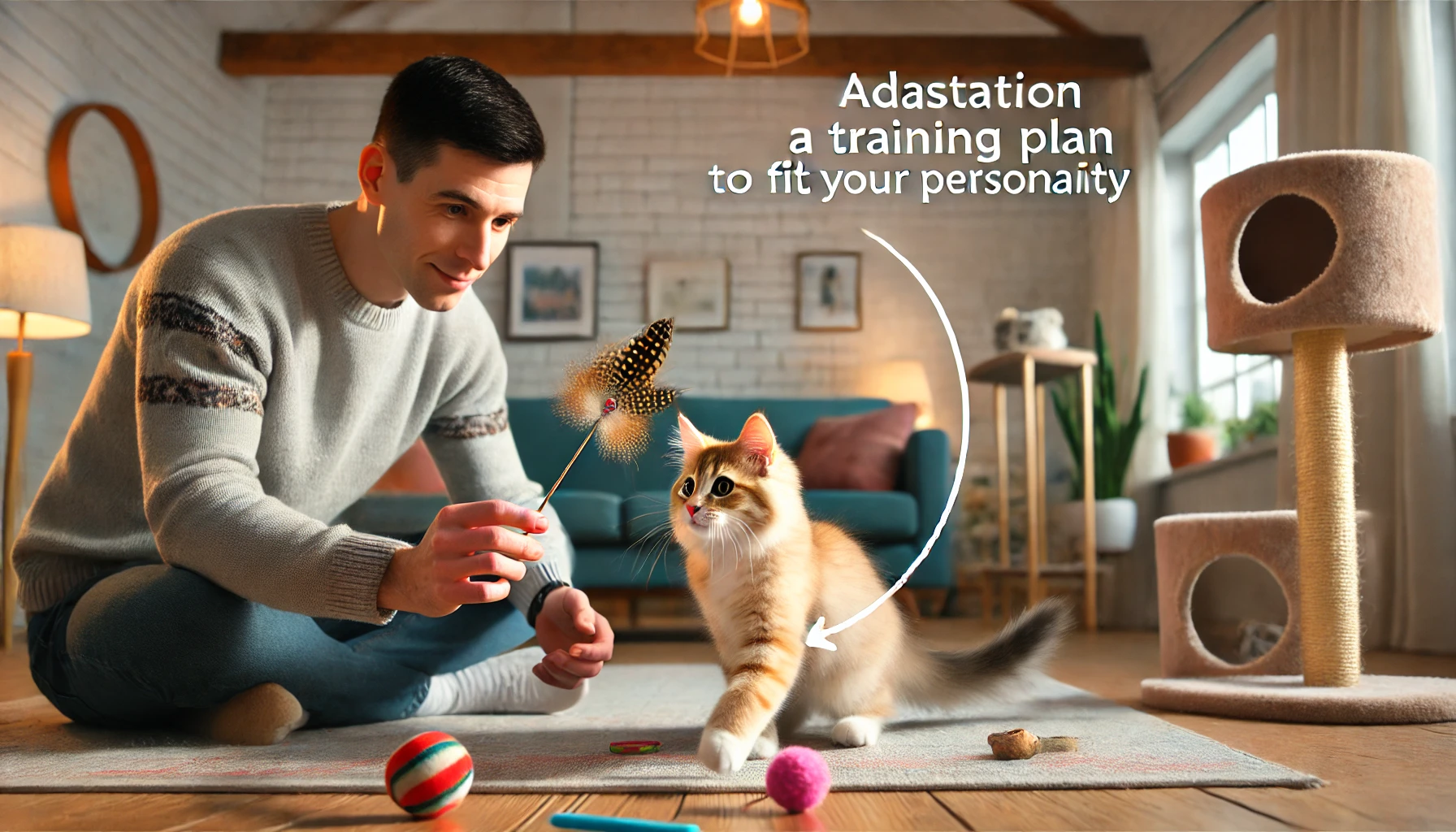
Changing the Plan to Fit Your Kitten’s Personality
Every kitten is different, and their personality will influence how they respond to training.
Some kittens are independent, while others are eager to please.
Matching your training plan to your kitten’s temperament will make the process easier and more enjoyable for both of you.
Here are some tips for adjusting your training plan:
- Shy kittens: Use a calm and gentle approach, allowing them time to get comfortable with training. Keep sessions short and use treats to build trust.
- Energetic kittens: Channel their energy into productive training sessions. Incorporate play into the training to keep them engaged.
- Stubborn kittens: Be patient and consistent. Use rewards to motivate them and don’t be discouraged if progress is slow.
The core of a successful training plan is understanding your kitten’s behavior and needs.
If you pay attention to how they learn, recognize signs of stress, and adjust the plan to fit their personality, you will create a training plan that works for both you and your kitten.
Recognizing your kitten’s developmental stages is essential for creating a personalized training plan that addresses their instincts and behavior.

Building a Gradual Kitten Training Plan
To successfully train your kitten, you need a structured and comprehensive training plan.
A well-thought-out plan helps you stay organized and ensures that your kitten learns progressively.
Breaking down the steps to train a kitten will allow you to tackle different aspects—from socialization to behavior correction—in easy steps.
Keep in mind that any form of training requires consistency and patience.
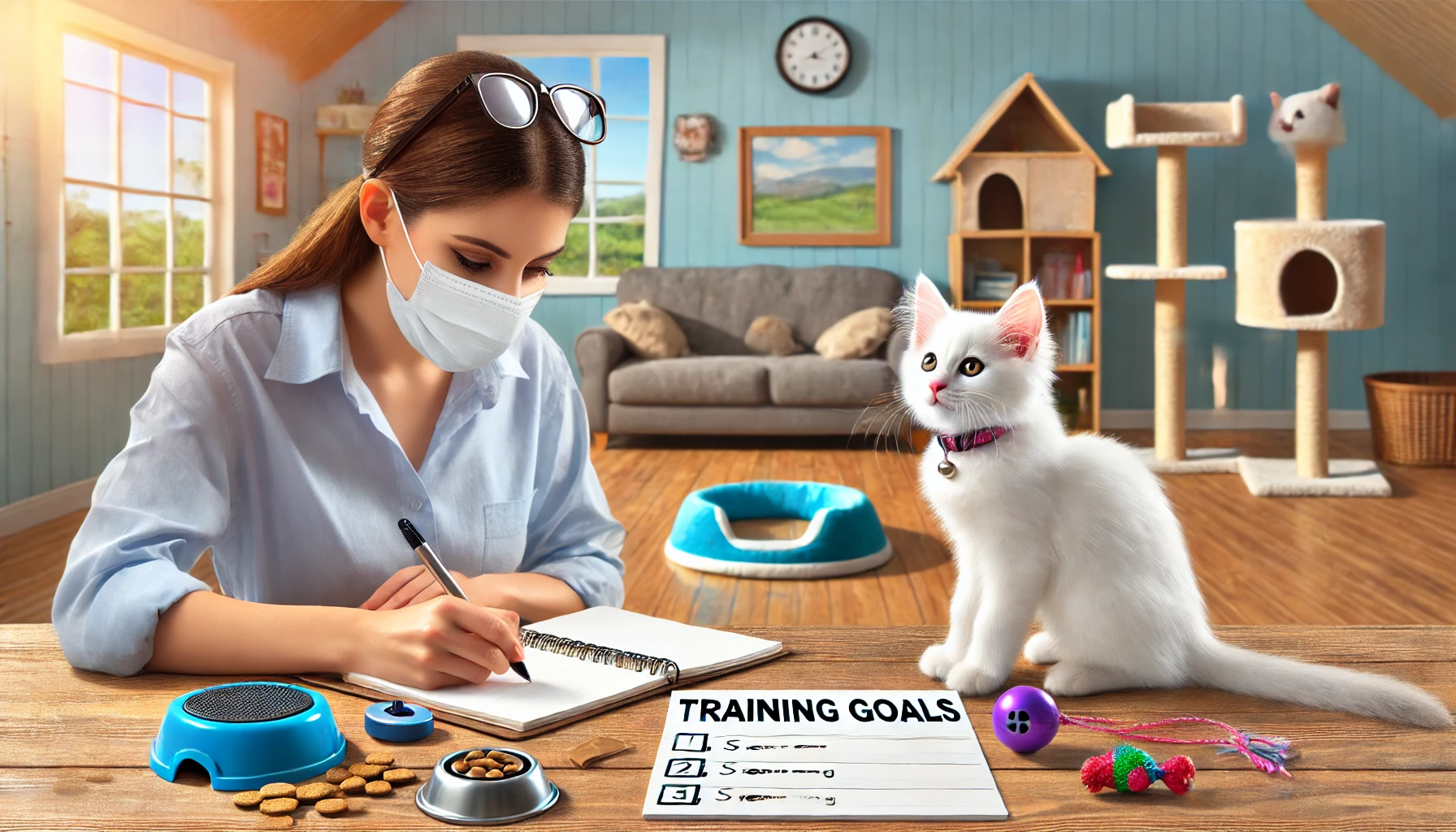
Setting Goals for Training
Before you start training, you should set clear and achievable goals.
What behaviors would you like your kitten to learn first?
Start with the basics, such as litter box training and teaching your kitten not to scratch furniture.
As your kitten progresses, you can introduce more advanced training, such as responding to commands or walking on a leash.
Setting both short-term and long-term goals will give you a roadmap and help track your kitten’s progress more clearly.
- Initial Goals: Litter training, setting boundaries, and curbing destructive behavior.
- Advanced Goals: Commands such as sit, stay, and come.
- Specific Goals: Leash training or teaching your kitten to interact with other pets.
By setting goals, you ensure that your training is structured and that you’re working towards measurable progress.
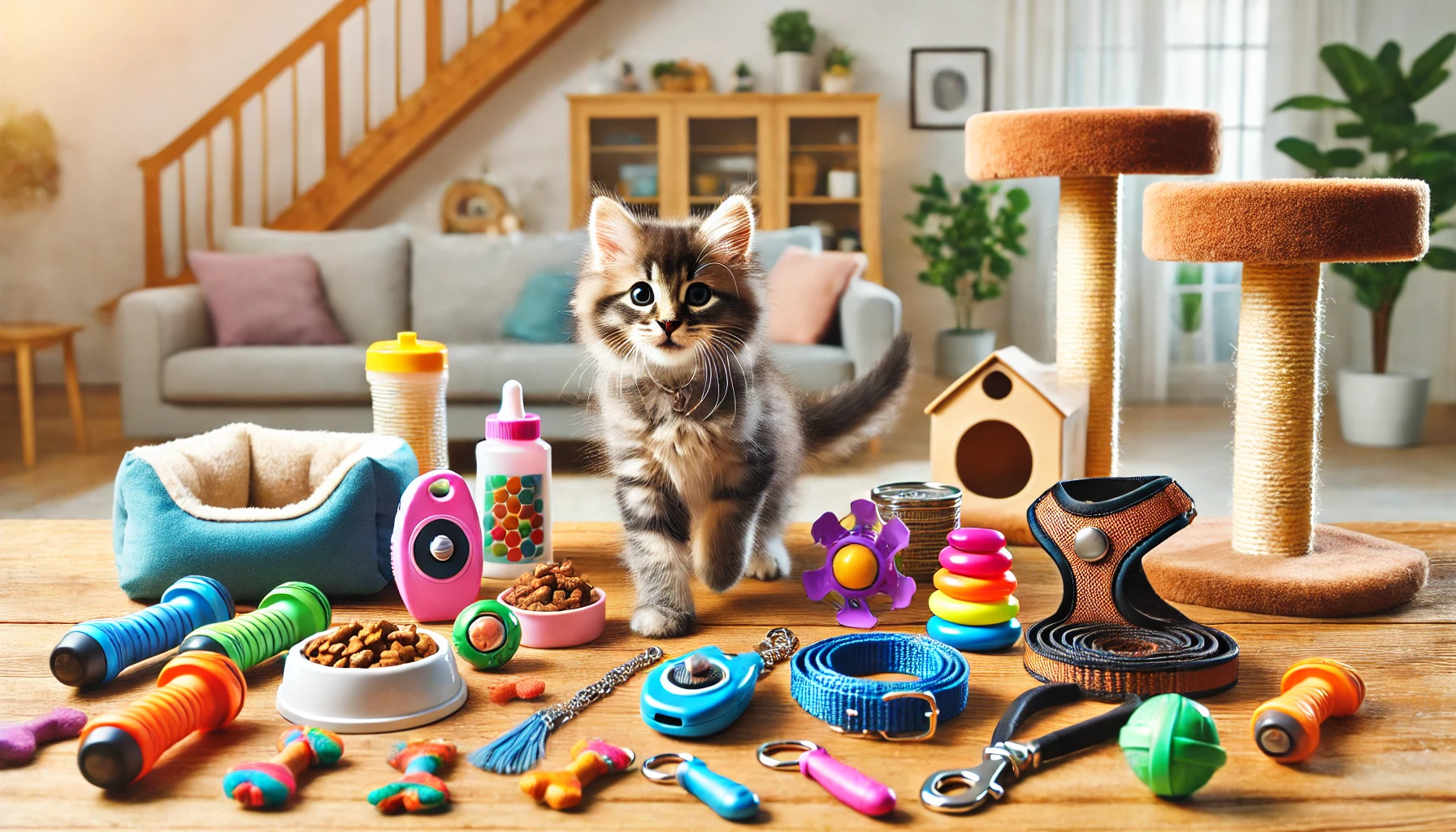
Training Tools You’ll Need
Having the right tools on hand will make training your kitten easier.
Several helpful tools can aid in the process.
Here are some common tools used during kitten training:
- Clicker: A clicker is often used in clicker training, where you make a clicking sound when your kitten performs a desired behavior, followed by a treat.
- Treats: Treats are one of the best ways to reinforce positive behavior. Choose treats that your kitten enjoys, but make sure they are healthy and small enough to give frequently.
- Scratching posts: If scratching is an issue, scratching posts provide a designated outlet for your kitten and help protect your furniture.
- Toys: Interactive toys are useful for channeling your kitten’s energy and encouraging proper play behavior.
- Leash and harness: If you plan to train your kitten to walk on a leash, invest in a comfortable, well-fitted harness and leash designed for cats.
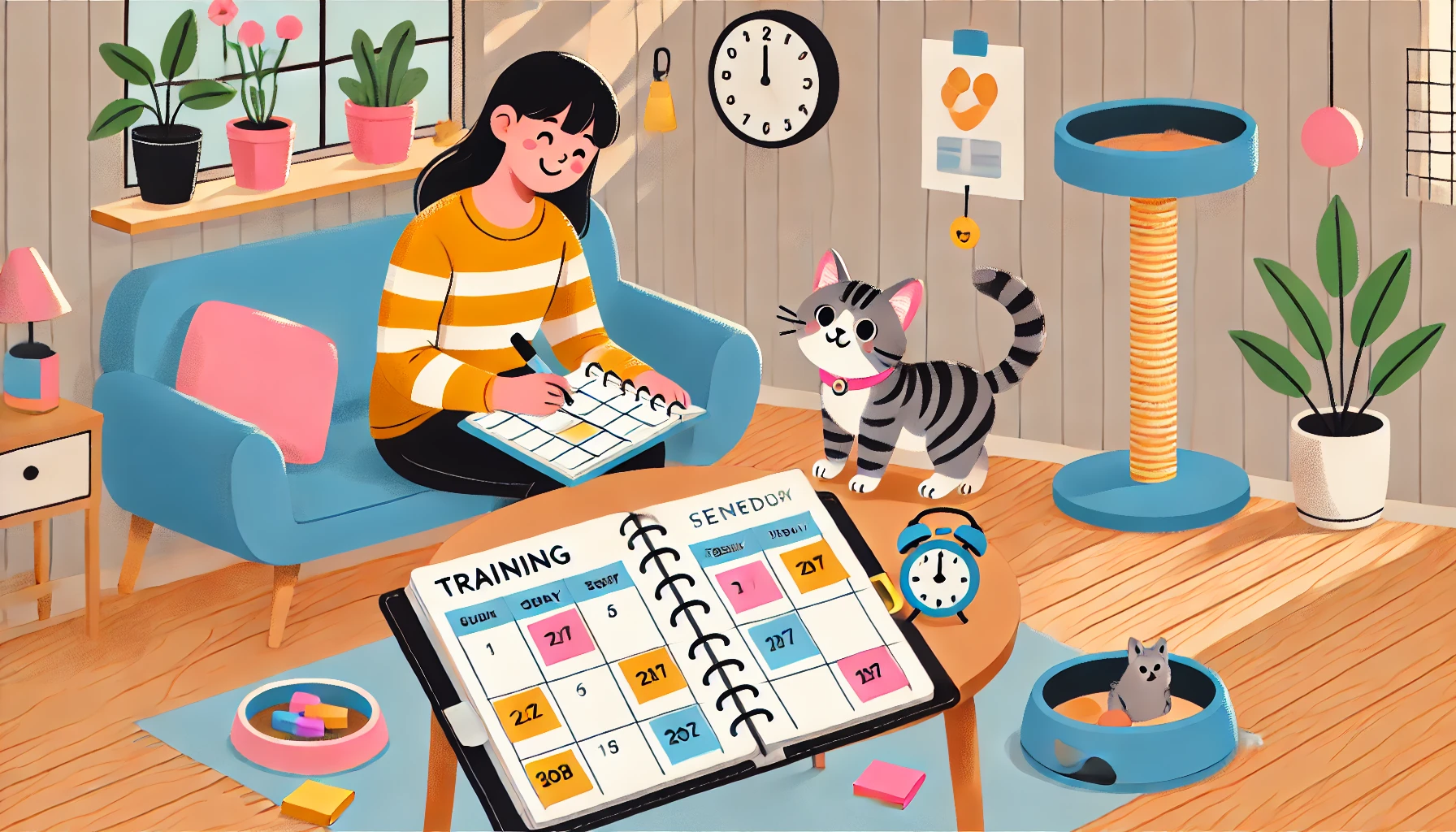
How to Establish a Training Schedule
A consistent training schedule is crucial for forming good habits in your kitten.
Establish set times each day for training, and be consistent.
Training sessions should be short—about 5 to 10 minutes—so your kitten doesn’t become bored or distracted.
Over time, gradually increase the difficulty of the tasks during these sessions.
Here is a basic schedule example:
- Morning: Start the day with basic litter box training and simple commands.
- Afternoon: Break up play-based training sessions, focusing on socialization and discouraging unwanted behaviors.
- Evening: Reinforce commands learned earlier in the day and introduce leash training, if applicable.
A consistent routine helps ensure progress and reinforces the behaviors you want your kitten to adopt.

Consistency and Patience in Training
Consistency is the key to successful kitten training.
Kittens thrive on routine and the repetition of behaviors.
Make sure your commands and rewards are consistent, and everyone in the household follows the same rules.
For example, if you want to keep your kitten off certain furniture, everyone must enforce this rule.
Patience is just as important.
Kittens are learning something new, so it’s natural for them to make mistakes.
Training takes time, so be prepared to repeat lessons and maintain a calm, encouraging attitude.
With persistence, your kitten will learn and adapt to the training.

Tracking Progress and Making Adjustments
As you go through the training process, keep track of your kitten’s progress.
Observe how quickly they are mastering certain tasks, and be ready to adjust your approach as needed.
Some kittens may take longer to learn certain behaviors, while others may surprise you with how quickly they adapt.
- Be flexible: If your kitten is struggling with a particular task, break it down into smaller steps or adjust your training method.
- Celebrate small successes: Acknowledge your kitten’s progress, even if it’s just a small improvement. Positive reinforcement helps build their confidence.
- Stay consistent: Stick to your plan, but be willing to make adjustments if necessary.
By monitoring your kitten’s progress and making adjustments as needed, you can create a more effective and enjoyable training experience for both you and your kitten.
A structured, step-by-step training plan ensures your kitten learns progressively and effectively.
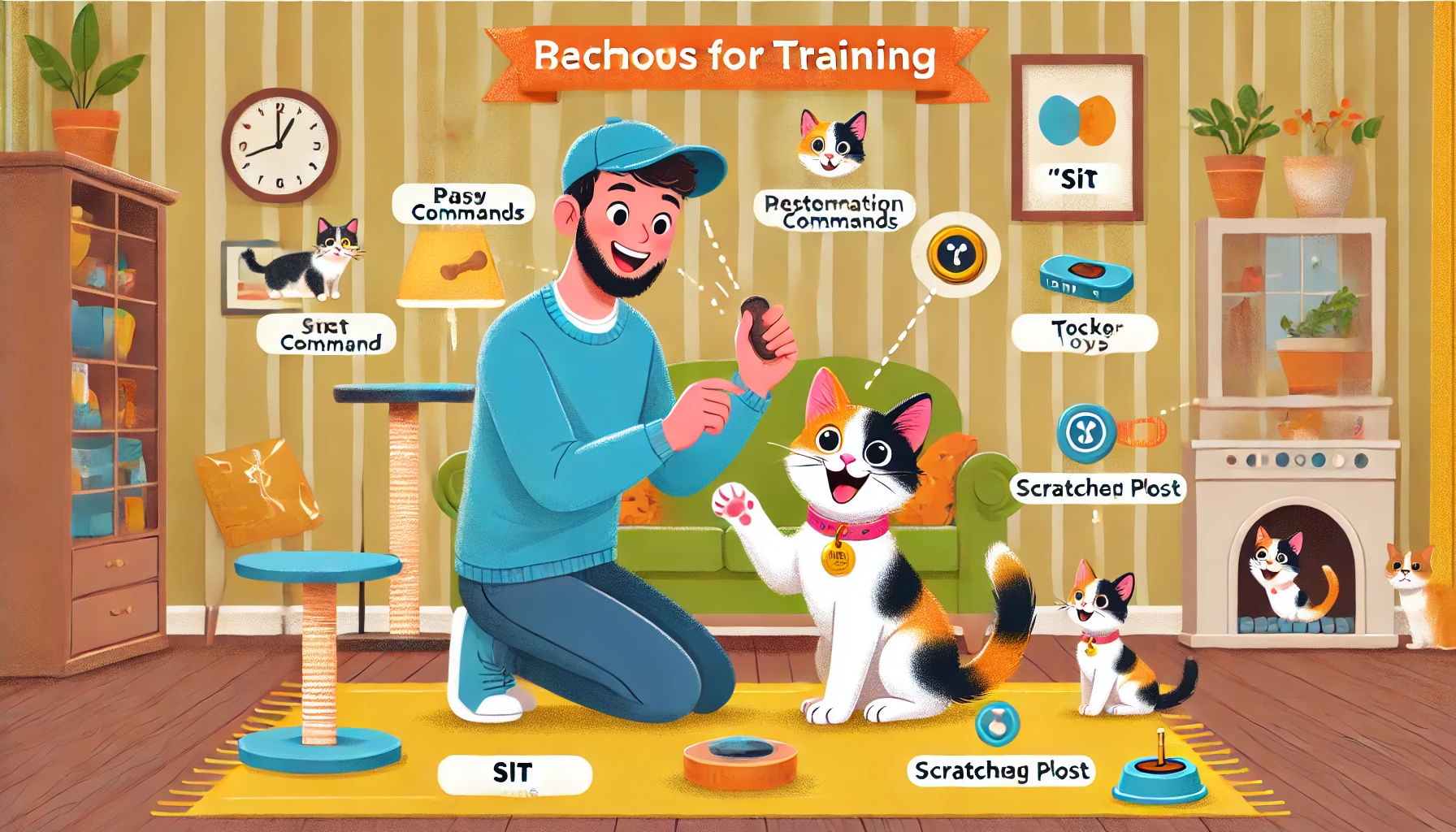
Basic Commands and Methods for Training Your Kitten
The prime requirement for raising your kitten into a well-behaved adult cat is to train them in basic commands and good behavior.
By teaching your kitten basic commands, you are laying the foundation for future training.
Commands related to litter training, sitting, and responding to their name can make a significant difference in your kitten’s life.
It also helps establish good communication between you and your feline companion.
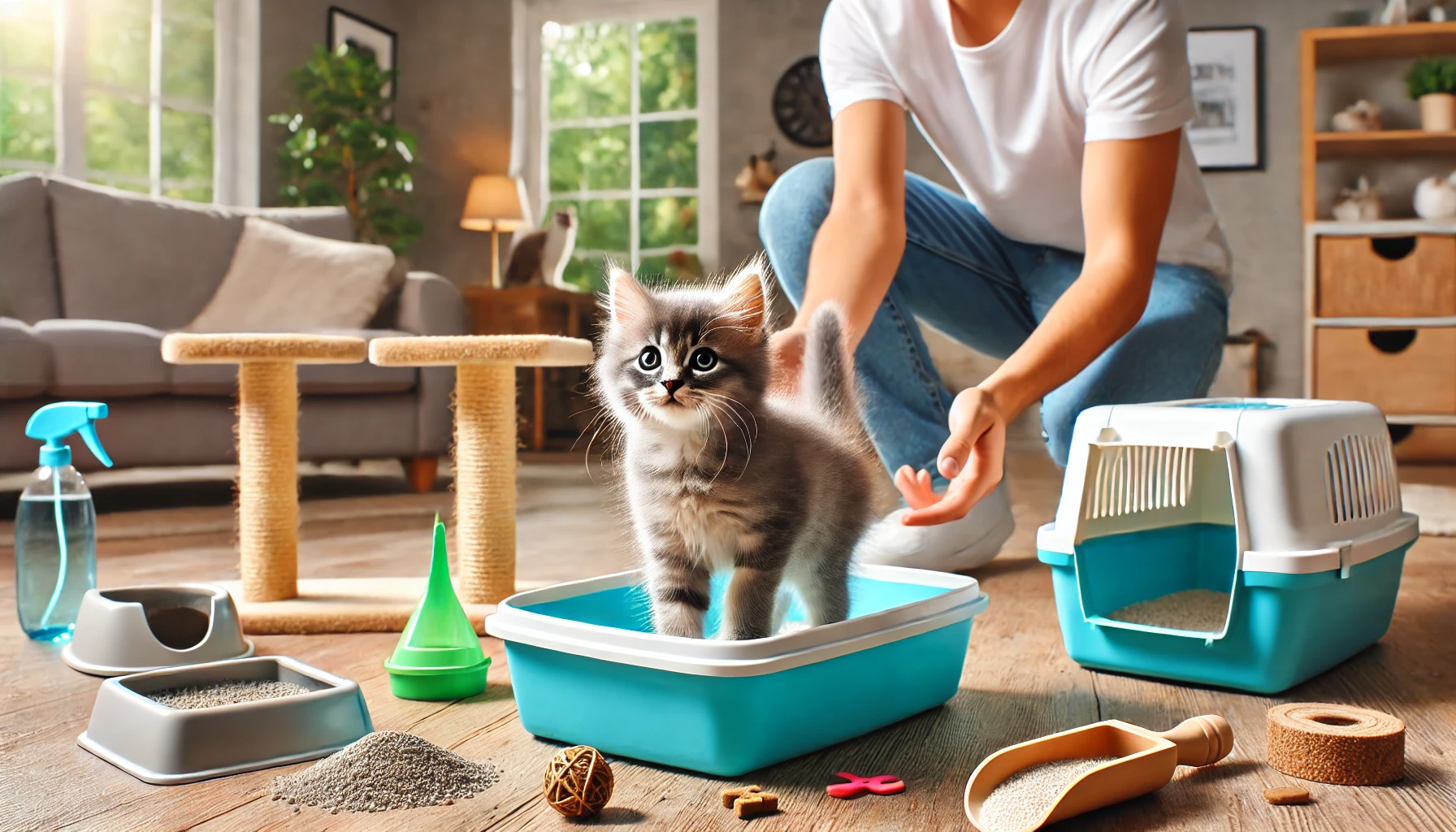
Litter Training Tips
One of the first and most important skills to teach your kitten is how to use a litter box.
Kittens generally learn to use the litter box quickly, but consistency and location are key to successful litter training.
Follow these steps to ensure success:
- Choose the right location: Place the litter box in a quiet, easy-to-access area of your home where your kitten can go without feeling vulnerable.
- Introduce your kitten to the litter box: Show your kitten the litter box immediately when you bring them home, and gently place them inside to get them familiar with it.
- Reward positive behavior: Each time your kitten uses the litter box, offer praise or a small treat to encourage the behavior.
- Clean the litter box regularly: A clean litter box motivates your kitten to keep using it. Scoop daily and clean the entire box weekly.
- Be patient: Accidents will happen. Gently guide your kitten back to the litter box and encourage them to try again.

Teaching Basic Commands: Sit, Stay, Come
Just like dogs, kittens can be trained to follow basic commands such as sit, stay, and come.
These commands not only help with discipline but also stimulate your kitten’s mind.
- Sit: Use a treat to get your kitten to sit by holding the treat near their nose and slowly raising it above their head. As they follow the treat, their bottom will naturally move into a sitting position. Reward immediately with a treat or praise.
- Stay: Once your kitten has learned to sit, add the “stay” command. Ask your kitten to sit, hold your hand out, and say “stay.” Take a small step back, and if they don’t move, reward them. Gradually increase the distance and duration.
- Come: Call your kitten’s name in a calm, happy voice. When they approach you, reward them with a treat. Repeating this often will help your kitten associate their name with positive reinforcement.
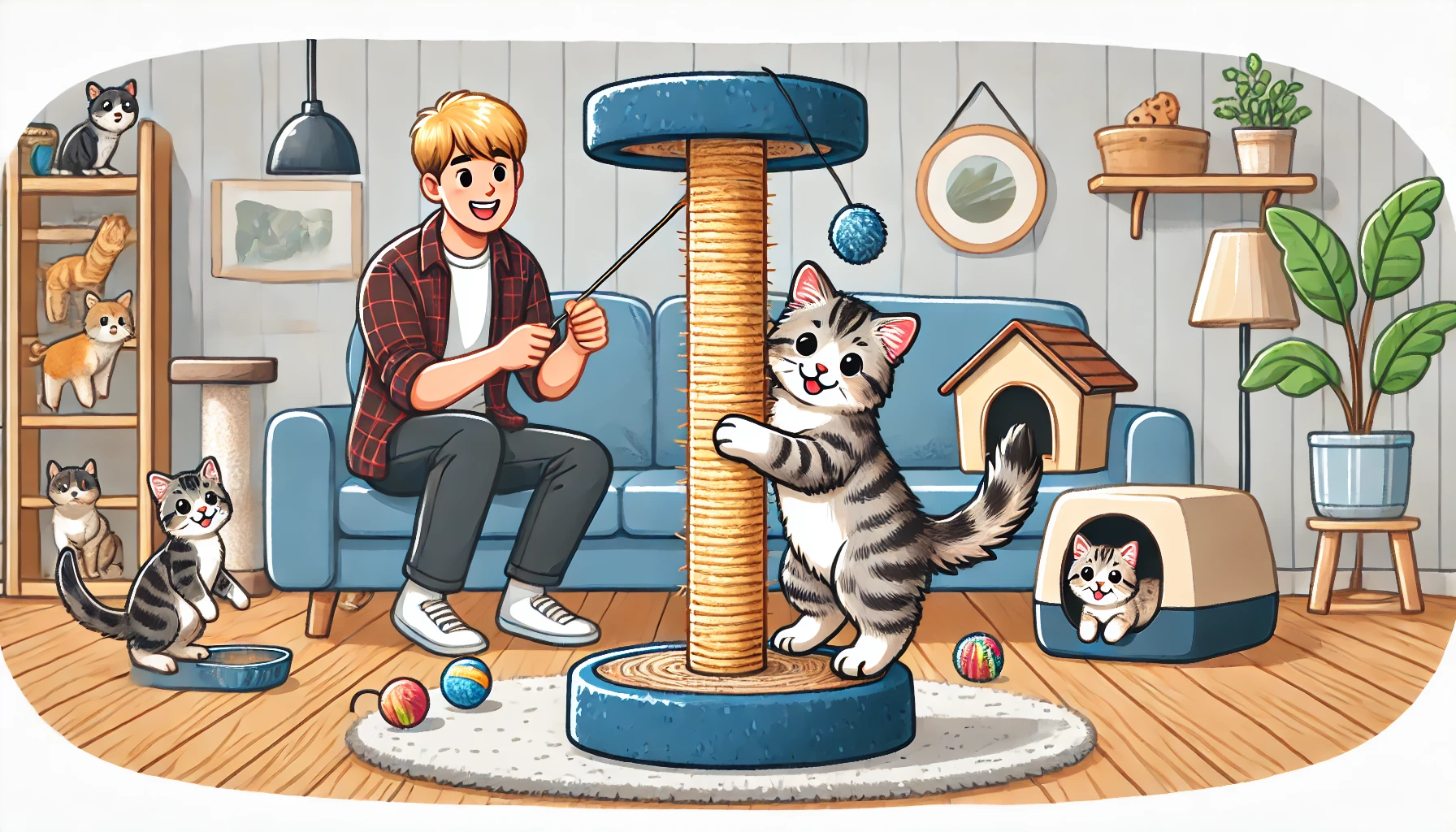
Dealing with Scratching Behavior in Kittens
Scratching is a natural behavior for kittens, but it can become destructive if not managed.
Training your kitten to scratch on appropriate surfaces, such as scratching posts, is important for their health and for protecting your furniture.
- Provide multiple scratching posts: Place several scratching posts throughout your home to give your kitten different options. Vertical and horizontal posts allow them to stretch and scratch in various ways.
- Encourage the use of scratching posts: If your kitten starts scratching furniture, gently redirect them to a scratching post. You can make the post more attractive by sprinkling catnip on it or offering treats when they use it.
- Reward good scratching behavior: When your kitten uses the post, offer praise or a small treat to reinforce the behavior.

Training Your Kitten to Use Scratching Posts
Beyond managing scratching behavior, you should actively train your kitten to use the scratching posts you’ve provided.
Scratching helps kittens sharpen their claws, mark territory, and stretch their muscles.
- Place scratching posts in key areas: Set up posts near areas where your kitten tends to scratch or rest. This increases the likelihood of consistent use.
- Positive reinforcement: Each time your kitten uses the post, praise them or offer a treat to encourage the behavior.
- Use catnip: Rubbing a small amount of catnip on the post can make it more attractive and encourage your kitten to scratch it.
- Patience is key: Redirect your kitten every time they scratch inappropriately, and reward them when they use the correct surface.
By training your kitten in these basic commands and techniques, you make life easier for both yourself and your pet.
A well-trained kitten will grow into a well-behaved adult cat.
With patience and persistence, the training process will be well worth it in the end.
Teaching basic commands like sit, stay, and come lays the foundation for discipline and a well-behaved adult cat.

Socializing and Rewarding Your Kitten During Training
Socializing your kitten is just as important as providing them with training on basic commands.
Proper socialization helps your kitten feel comfortable in various situations and with different people or animals.
In this way, they become an outgoing, well-adjusted, and confident adult cat.
Along with socialization, using positive reinforcement during training builds trust and encourages good behavior in kittens.

The Importance of Socializing with Other Pets
Socializing your kitten with other pets helps them learn how to behave around other animals.
This is especially important if you have other cats, dogs, or pets at home.
Here’s how to begin:
- Introduce slowly: Introduce your kitten to one resident pet at a time. Initially, keep them on opposite sides of a door, allowing them to sniff each other through a gap to get used to each other’s scent without direct interaction.
- Employ supervised interactions: After a few days of scent introduction, allow supervised visual encounters. Keep these sessions short and use treats or toys to create positive associations.
- Observe body language: If your kitten or the other pet shows signs of stress, such as hissing, growling, or hiding, give them more space and time. Never force interactions, as this can worsen the situation.
Patient and gentle introductions will help your kitten learn how to socialize safely with other pets.

Positive Reinforcement in Training
Positive reinforcement works wonders in training kittens.
This method involves rewarding desired behavior with treats or praise, encouraging your kitten to repeat the action.
It’s effective for both basic commands and more advanced behaviors.
Here’s how to apply positive reinforcement:
- Reward: Use treats, praise, and affection as rewards. Ensure the reward is something your kitten enjoys, and give it immediately after the desired behavior.
- Timing: Timing is everything. Rewards must be given right after the behavior to create a clear link between the action and the positive outcome.
- Consistency: Be consistent with rewards. Make sure everyone in the household is rewarding desired behaviors to reinforce training goals.
- Avoid punishment: Punishing your kitten for unwanted behavior is counterproductive and can lead to fear or anxiety. Focus on rewarding positive behavior instead.
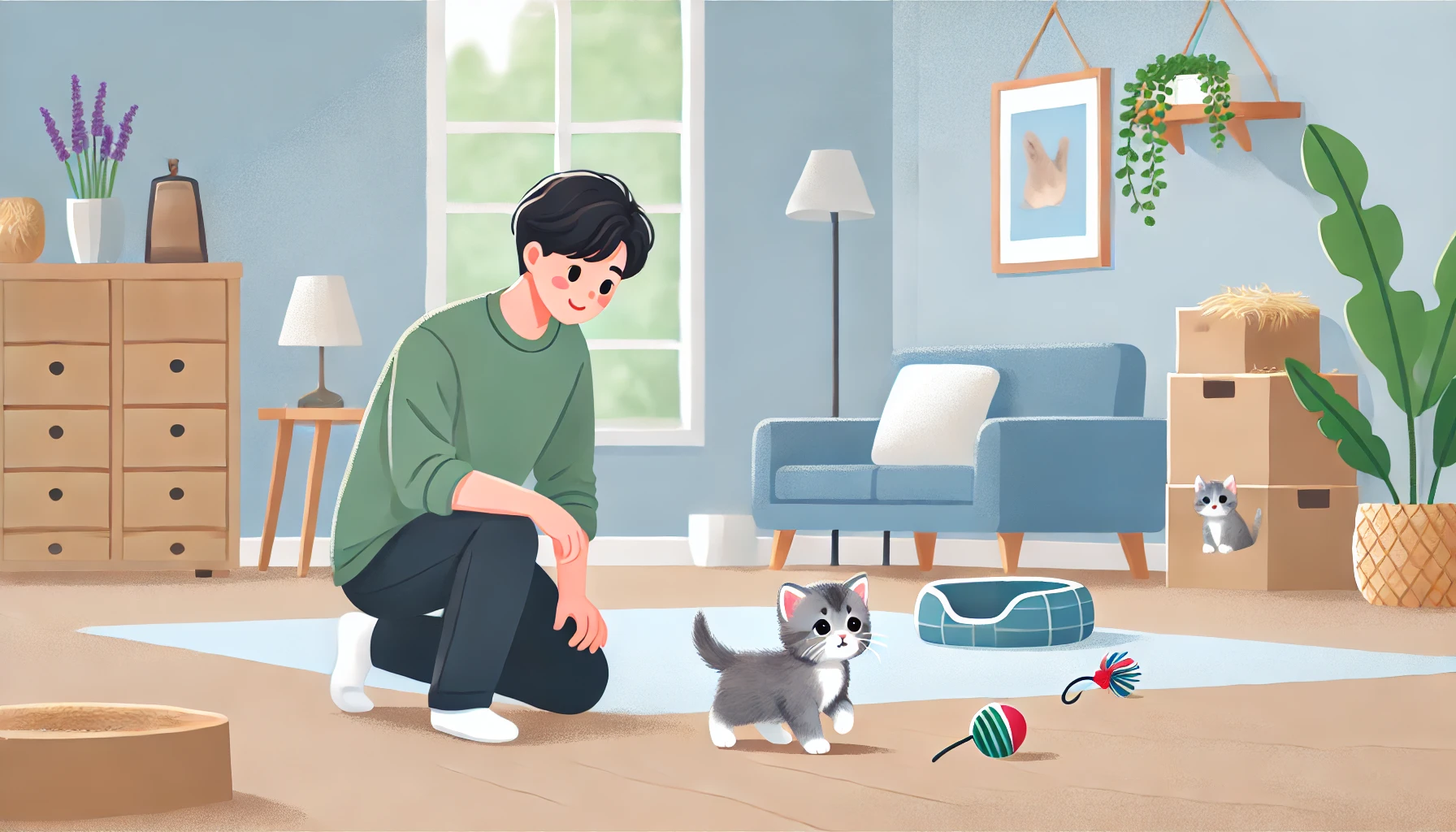
How to Safely Introduce New Environments
Kittens are sensitive to new environments, so introducing them to new places should be done gradually.
Whether you are introducing them to new rooms in the house or a completely new environment, follow these steps to make it easier:
- Start small: Let your kitten get comfortable in one room at a time. Once they are settled, you can gradually introduce them to other areas of the house.
- Use familiar objects: Bring along your kitten’s favorite toys, blanket, or bed when introducing them to new environments. Familiar objects can help reduce stress.
- Provide a safe space: Ensure your kitten has a quiet, comfortable place to retreat to if they feel overwhelmed.
- Stay calm: Your kitten will pick up on your energy, so remain calm and patient when introducing them to new environments, allowing them to explore at their own pace.

Rewarding Good Behavior Effectively
Rewarding good behavior is essential to reinforcing your kitten’s training and strengthening your bond.
Here’s how to reward effectively:
- High-value rewards: Use treats your kitten loves but doesn’t get often to make the reward extra special and more effective.
- Keep rewards small: Since you’ll be giving rewards frequently during training, keep them small to avoid overfeeding.
- Incorporate praise and affection: In addition to treats, use verbal praise and physical affection to reward your kitten. This helps build a stronger bond.
- Be consistent: Always reward good behavior immediately so your kitten understands what they are being rewarded for.
Using positive reinforcement and consistent rewards will help your kitten learn faster and build confidence during training.
Socializing your kitten with pets and people while using positive reinforcement helps them grow into a confident, well-behaved cat.
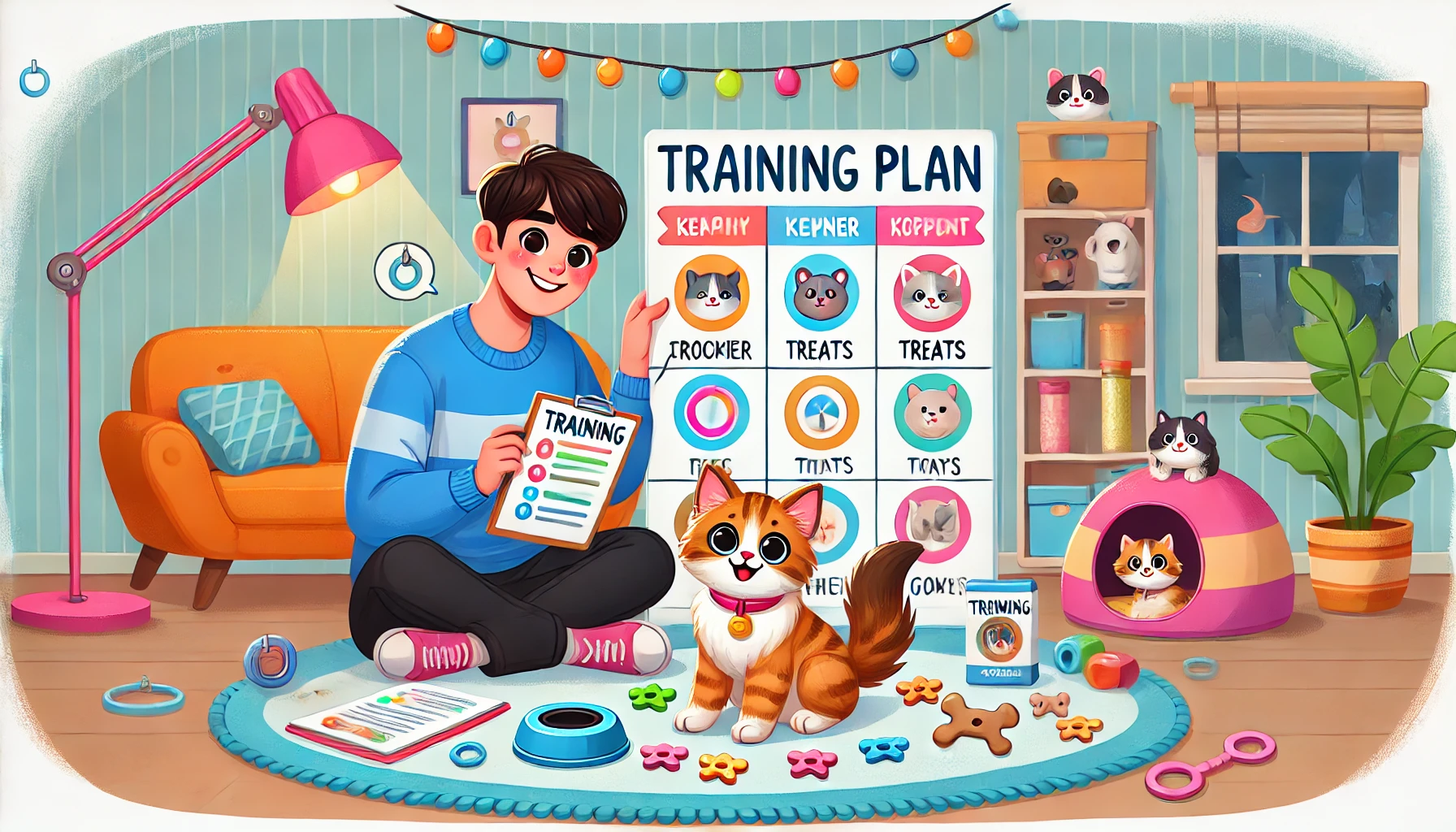
Creating the Purr-fect Training Plan for Your Kitten: Summary
Training is an essential aspect of helping your kitten grow into a well-disciplined, confident, and happy adult cat.
Patience, consistency, and understanding your kitten’s specific behaviors and needs are crucial to this process.
This article has outlined the steps you can take to develop an effective training plan, from litter training to socialization, teaching basic commands, and addressing common behavioral challenges, such as scratching.

A Structured Training Plan is a Necessity
A structured training plan lays the foundation for long-term success.
By setting clear goals from the outset, you can focus on main areas of concern, such as litter box training and boundary setting.
As your kitten progresses, you can gradually introduce more complex behaviors, like teaching them to sit, stay, and even walk on a leash.
Every training session, no matter how minor, helps build trust with your kitten.
Consistency is key in any training plan.
Kittens learn and adapt more quickly when practice is regular, reinforcing the desired behaviors.
Tools like clickers, treats, and scratching posts make the training process smoother and more enjoyable for both you and your kitten.

Primary Commands and Behavior Training
Basic commands like “sit,” “stay,” and “come” establish a strong foundation for your kitten’s discipline.
These commands not only keep your kitten safe but also provide mental stimulation.
In addition to basic commands, addressing behaviors like scratching is essential to protecting your home while encouraging healthy habits for your kitten.
Positive reinforcement is the most effective technique to encourage good behaviors.
Immediately rewarding your kitten with treats and praise after they perform well helps them remember the action.
Avoid punishing your kitten, as it can create fear and anxiety, which hinders their learning process.
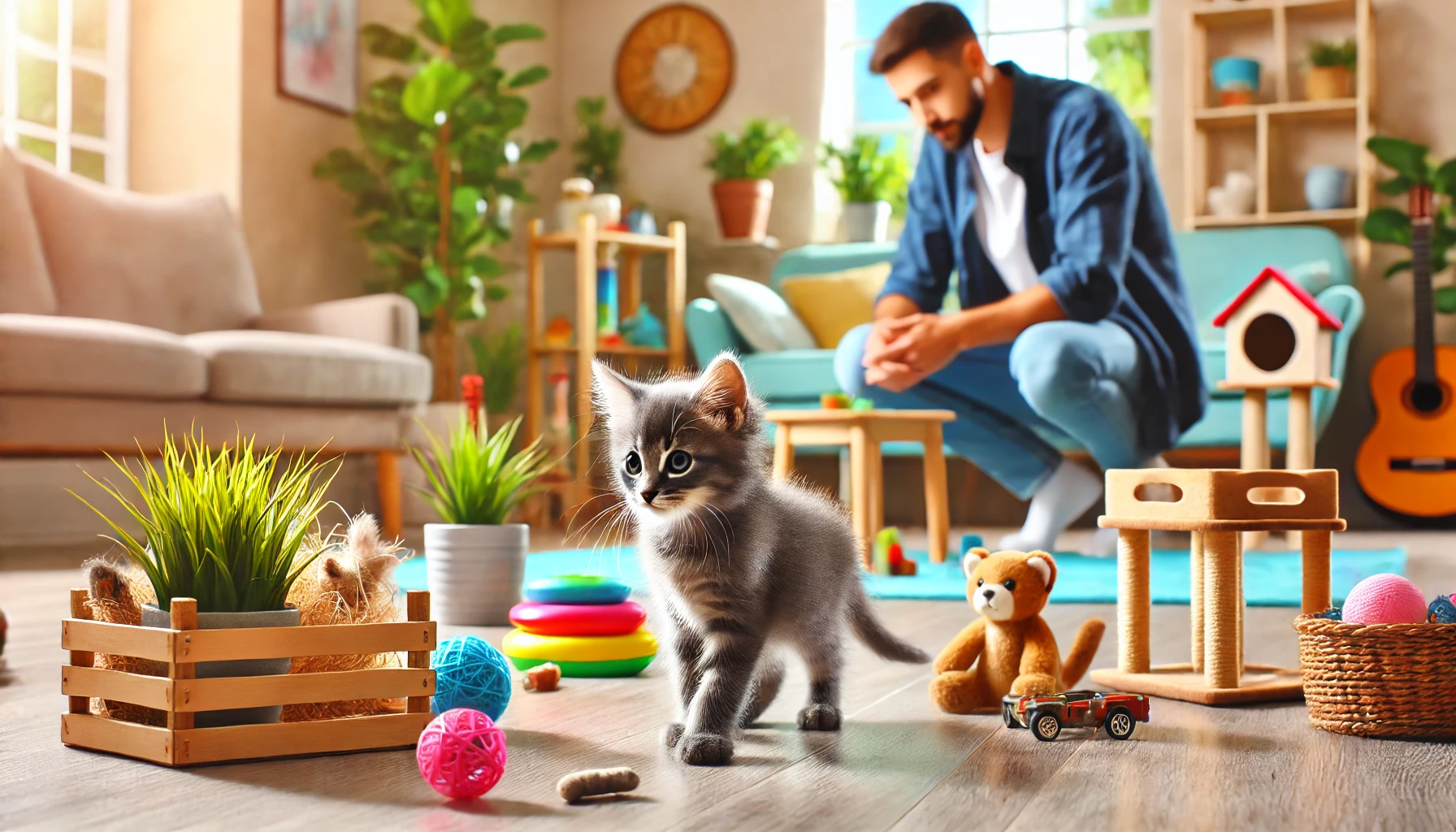
Socialization and Environmental Exposure
Socializing your kitten with other pets and exposing them to new environments is vital for building their confidence.
Gradual exposure to new pets, people, and surroundings allows your kitten to adapt without becoming anxious or overwhelmed.
Positive reinforcement during socialization helps your kitten associate new experiences with positive outcomes.
Let your kitten explore new spaces at their own pace, starting small and gradually expanding their environment.
Introducing familiar objects, such as favorite toys or blankets, can make new areas feel less intimidating.
Providing your kitten with a safe space to retreat to when they feel stressed is another important aspect of socialization.

Conclusion on Your Kitten’s Training Process
Developing a comprehensive training plan for your kitten is a rewarding experience that brings you closer to your pet.
Patience, consistency, and the use of proper tools will help guide your kitten through key developmental milestones, shaping them into a well-adjusted and obedient adult cat.
The steps in the training plan—from litter training to socialization and beyond—help you better understand your kitten’s needs.
By focusing on positive reinforcement, setting clear goals, and gradually introducing new experiences, you ensure that their training is both effective and enjoyable.
Remember, training is a continuous journey that requires effort, but the reward is a happy, healthy, and well-behaved cat who will be your loving companion for years to come.
A well-structured and consistent training plan ensures your kitten grows into a well-adjusted, confident adult cat.

Frequently Asked Questions About Kitten Training Plans
Here are answers to some of the most common questions regarding developing a training plan for your kitten.
Whether you are working on litter training, socialization, or basic commands, these FAQs will guide you through the process.
When should I start training my kitten?
Training should start by the time your kitten is 8 weeks old.
At this young age, kittens are more receptive to learning, allowing their basic commands and good habits to be easily established.
How long should each training session last?
Each training session should last around 5 to 10 minutes.
Kittens have short attention spans, so keeping sessions brief and fun helps maintain their focus and prevents frustration.
What are some good treats for training kittens?
Small, soft treats are ideal for training kittens.
Choose treats that your kitten enjoys and are healthy.
Ensure they are small enough to give multiple times during a session without overfeeding.
Can I leash train my kitten?
Yes, kittens can be leash trained.
Use a harness designed specifically for cats, and gradually introduce the leash during short indoor training sessions before transitioning to outdoor walks.
How do I stop my kitten from scratching furniture?
Provide scratching posts in different rooms of your house.
When your kitten starts scratching furniture, gently redirect them to the scratching post and reward them for using the correct surface.
How do I socialize my kitten with other pets?
Gradually introduce your kitten to other pets in the household.
Start by allowing them to get used to each other’s scent through a closed door before moving to short, supervised face-to-face interactions.
What is the best way to reinforce good behavior?
Treats, praise, and affection are the best ways to reinforce good behavior.
Reward your kitten immediately after they perform a desired action to establish a clear connection between the behavior and the reward.
How can I teach my kitten to respond to their name?
Call your kitten’s name in a happy, calm tone.
Reward them with a treat when they respond.
Repetition and consistency are key to helping your kitten associate their name with positive reinforcement.
How can I determine if my kitten is stressed when training?
Signs of stress include hiding, excessive meowing, hissing, or avoiding interaction.
If you notice any of these behaviors, slow down the training process, give your kitten a break, and adjust your methods to ensure their comfort.





